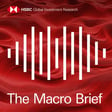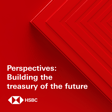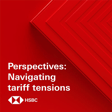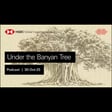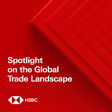Become a Creator today!Start creating today - Share your story with the world!
Start for free
00:00:00
00:00:01

Financing Biodiversity: Risks and Opportunities
In this episode we look back on Marine de Bazelaire, HSBC Group Advisor on Natural Capital, at the Economist Sustainability Week discussing the rise of natural capital alongside Eric Usher, Head of the UN Environment Programme Finance Initiative, and Willem Evers, Dutch Central Bank Head of Sustainable Finance Office.
Could nature-based investing be the next big asset class and what financial opportunities arise from this? How can investment in the preservation of biodiversity be unlocked?
To find out more about HSBC’s Business Plan for the Planet and how you can play your part, click here.
For more information about the Economist Sustainability Week, click here.
Hosted on Acast. See acast.com/privacy for more information.
Transcript
Introduction to HSBC Global Viewpoint & Business Plan for the Planet
00:00:00
Speaker
This is HSBC Global Viewpoint, your window into the thinking, trends and issues shaping global banking and markets.
00:00:09
Speaker
Join us as we hear from industry leaders and HSBC experts on the latest insights and opportunities for your business.
00:00:18
Speaker
A heads up to our listeners that this episode has been recorded remotely, therefore the sound quality may vary.
00:00:24
Speaker
Thank you for listening.
00:00:31
Speaker
Welcome to the Business Plan for the Planet podcast, a series centered around ESG insights.
00:00:37
Speaker
In these episodes, you'll hear from experts whose work is at the heart of sustainability linked trends and opportunities, as well as from businesses that are delivering change for a better future for us all.
00:00:47
Speaker
Join us as we shine a spotlight on their commitment to a sustainable future.
Panel Introduction on Biodiversity Financing
00:00:53
Speaker
Good afternoon and thank you for joining us on the discussion about financing biodiversity, risks, opportunities and challenge.
00:01:02
Speaker
My name is Nina Seega.
00:01:04
Speaker
I'm a research director responsible for sustainable finance at the Cambridge Institute for Sustainability Leadership.
00:01:11
Speaker
I've got an absolutely fantastic panel here with me.
00:01:15
Speaker
Let me start by introducing them before we have hopefully an overarching and interesting conversation around all things biodiversity.
00:01:25
Speaker
Let me start with introducing
00:01:27
Speaker
Eric Usher, who is the head of the United Nations Environment Programme Finance Initiative.
00:01:33
Speaker
We're also joined by Maureen de Bazelaire, who is a group advisor to HSBC on natural capital, and she's also an executive committee member for HSBC Continental Europe.
00:01:45
Speaker
And last, but absolutely definitely not least, we've got Willem Evers,
00:01:51
Speaker
who is the head of the Sustainable Finance Office at the D&B, the Dutch Central Bank.
00:01:57
Speaker
And his job is to coordinate all work in the area of sustainable finance and the central bank and supervisor, as well as represent D&B on sustainable finance related issues.
00:02:10
Speaker
So welcome everybody to the panel.
00:02:12
Speaker
Let's jump right in.
Understanding Bank Impacts on Biodiversity
00:02:15
Speaker
And I will start with asking Eric about the impact
00:02:20
Speaker
of financial services on biodiversity.
00:02:24
Speaker
So how can banks, investors, insurers and other businesses in the financial sector understand their impact on biodiversity?
00:02:32
Speaker
Thanks very much, Nina, and a pleasure to be with you for today's discussion.
00:02:36
Speaker
I think we can start to break down the notion of biodiversity and nature related risks
00:02:42
Speaker
across financial portfolios.
00:02:44
Speaker
And in some ways they're similar in terms of taxonomy to climate related losses.
00:02:50
Speaker
And of course the two interact with various feedback loops.
00:02:54
Speaker
And the financial risks here are described as related to four specific areas of risk.
00:02:59
Speaker
The first being the physical impacts of biodiversity loss.
00:03:02
Speaker
The second being the systemic impacts.
00:03:04
Speaker
biodiversity loss, the third being the litigation and around biodiversity loss and breach of underlying legal frameworks.
00:03:13
Speaker
And fourth, the notion of the transition to an economy which addresses these risks and losses and what implications that has on existing business models.
00:03:23
Speaker
So in terms of how financial institutions can get started, the same approach is through the model Encore, which is a tool that helps financial institutions assess their exposure to nature-related risks.
00:03:36
Speaker
It explores the dependencies on natural capital of specific economic activities such as
00:03:43
Speaker
power generation or different forms of agriculture, and the effects of changes in the condition of natural assets on business viability.
00:03:51
Speaker
Potential disruptions in the provision of ecosystem services, for instance, the dying off of pollinators, are linked to business production processes by what we call an ecosystem service materiality assessment.
Aligning Finance with Nature Objectives
00:04:06
Speaker
The Natural Capital Protocol is another example of a framework for conducting natural capital assessments
00:04:12
Speaker
Final point, I think though around the opportunistic side is it's not just about seeking out these specific opportunities.
00:04:19
Speaker
Everyone can do a bit of this, a bit of that, included in our sustainability reports, and then continue with business as usual.
00:04:26
Speaker
And so I think, you know, like with climate action,
00:04:30
Speaker
For the finance sector to really play its role in stabilizing, reversing nature loss, it has to go beyond just seeking out opportunities.
00:04:38
Speaker
And it really needs to start looking at how can they align entire portfolios with the nature objective.
00:04:45
Speaker
Can I actually draw you up on that last point around alignment?
00:04:49
Speaker
So within the climate sphere, it's a relative.
00:04:52
Speaker
We now have a relatively easy anchor to align ourselves.
00:04:56
Speaker
It's the one and a half degree warming.
00:04:59
Speaker
What can be used within the biodiversity space to achieve the same objective?
Setting Biodiversity Targets in Finance
00:05:04
Speaker
It's a key question.
00:05:05
Speaker
I mean, I think, you know, for financial institutions,
00:05:08
Speaker
who need to start thinking about this really holistically.
00:05:12
Speaker
How do we align financial flows with the conservation, restoration and sustainable use of biodiversity?
00:05:19
Speaker
It's a tough question.
00:05:21
Speaker
We do hope that this sort of nature alignment will be clearly called for in the next version of the CBD, the Convention for Biological Diversity, and specifically their post-2020 global biodiversity framework, which is expected to be released later this year.
00:05:37
Speaker
I think the next step once you have a broad framework is to start to set relevant targets, especially interim targets.
00:05:44
Speaker
For example, by establishing relevant policies at a minimum to do no harm or even considering exclusions.
00:05:53
Speaker
Certainly a concrete step is to start encouraging one's clients and customers to set their own science-based targets for nature.
00:06:00
Speaker
Through the principles for responsible banking, we'll be releasing guidance for banks on setting biodiversity targets.
00:06:06
Speaker
This is being developed with the Science-Based Targets Network.
Risks Related to Biodiversity and Governmental Role
00:06:10
Speaker
Thanks, Eric.
00:06:10
Speaker
And if I actually bring Willem here also on the alignment point and on the various processes that are currently ongoing around the world that are driving us towards that alignment.
00:06:22
Speaker
Yes, thanks, Nina, and thanks, Eric, for your interesting introductory remarks.
00:06:26
Speaker
So I think we as a central bank and supervisor are relatively late to this party, but we've just beginning our journey to understand the impacts of biodiversity loss on the financial institutions and therefore our core tasks maintaining financial stability and
00:06:41
Speaker
maintaining institution stability as a supervisor.
00:06:44
Speaker
So I think one of the key risks, because that's the perspective that we tend to take as supervisors, one of the key risks is a transition risk.
00:06:53
Speaker
Now, if we do not understand these transition risks at a certain point, then there's this
00:06:59
Speaker
It's a clear risk that financial institutions will continue to have activities, landings, investments that will have a risk once society has a tipping point and transition is taking part.
00:07:13
Speaker
And that is just one angle.
00:07:15
Speaker
We also see as a supervisor the physical risk.
00:07:18
Speaker
So the actual risk.
00:07:19
Speaker
impacts on financial institutions' operations and loan books of a declining biodiversity.
00:07:27
Speaker
For example, 8% of all the global food crops is directly affected by animal pollination.
00:07:33
Speaker
So if you're exposed to these sorts of ecosystem services as a company, but also as a financier of such a company, then there's a direct physical risk if such a service is declined or even abolished all the way.
00:07:47
Speaker
And a third angle would be reputational risk.
00:07:50
Speaker
So we identified that there's biodiversity controversies.
00:07:55
Speaker
A lot of banks in the Netherlands, for example, are lending to companies which emit nitrogen.
00:08:02
Speaker
So this emittance, it disturbs the natural nitrogen cycle in which nature is protected and biodiversity loss is affected.
00:08:10
Speaker
And there's a clear societal tendency now to really
00:08:15
Speaker
look at financial institutions for their role in this scandal as it was perceived in Dutch society.
00:08:21
Speaker
So there's a growing societal awareness of the effects on their livelihood of a decline in biodiversity loss.
00:08:29
Speaker
So we think and we urge financial institutions to pay attention to these effects, both three types of risks in their activities.
00:08:39
Speaker
And especially on the alignment and the transition risk, we foresee that there's clear governmental roadmaps to be established in the upcoming years.
00:08:49
Speaker
And we urge them to take those into account as well.
00:08:53
Speaker
Thank you so
Assessing Nature-Related Risks in Banking
00:08:54
Speaker
much, Willem.
00:08:54
Speaker
And let me now bring in Maureen.
00:08:56
Speaker
Maureen, if I come to you right now and ask for your perspective on kind of how do banks see nature-related risks and their financial risk framework, especially as HSBC is part of our steering group for our handbook.
00:09:10
Speaker
So it's a relatively natural question to bring Maureen in on.
00:09:15
Speaker
Thank you very much, Nina.
00:09:16
Speaker
And thank you for looping me in this very interesting conference.
00:09:19
Speaker
So how do we approach
00:09:22
Speaker
biodiversity and natural capital loss.
00:09:25
Speaker
I would say maybe how do we assess this?
00:09:30
Speaker
How do we address those and is it effective?
00:09:33
Speaker
So how do we assess this?
00:09:36
Speaker
Will said a lot about the materiality of the risk.
00:09:39
Speaker
Taking a few figures, I mean, the EU estimates the losses in ecosystem services to range
00:09:49
Speaker
and from around 4 to 18 trillion per year between 1997 and 2011.
00:09:57
Speaker
So yes, the materiality of the risk is unquestionable for the financial industry.
00:10:05
Speaker
And how do we address those risks?
00:10:08
Speaker
Well, it's not new in a way.
00:10:11
Speaker
I mean, we have had sector policies
00:10:15
Speaker
to address the way we finance different sectors within the financial industry for a very long time, within HSBC since 2004.
00:10:26
Speaker
And it started with a dedicated one to forests and products derived from forestry.
00:10:34
Speaker
Being said that, I mean, is it effective?
00:10:37
Speaker
Well, up to the limit of it.
00:10:40
Speaker
Do we really understand what is the chain of consequences?
00:10:44
Speaker
Meaning, do we tackle the risks along the value chain?
00:10:49
Speaker
Are we able to translate those issues into a risk framework?
00:10:54
Speaker
Well, we have to be very humble at that stage.
00:10:58
Speaker
You may know that the Equator Principles has now included since July 2020 new commitments on biodiversity.
00:11:07
Speaker
and data sharing.
00:11:08
Speaker
And for the moment, it's quite aspirational, I would say.
00:11:13
Speaker
Not completely, but I mean, it brings us to commit to support conservation, including with the aim of improving the evidence base for research and decisions related to biodiversity.
00:11:26
Speaker
So meaning that we don't have all the right knowledge to really assess well those risks.
00:11:33
Speaker
And certainly the work
00:11:35
Speaker
from the Task Force on Nature-Related Financial Disclosure, the TNFD, will be key going forward.
00:11:42
Speaker
It's going to be launched mid-2021, but it will help us to understand and probably assess those risks.
00:11:49
Speaker
So I would say we're not starting from nothing.
00:11:53
Speaker
A lot is already done.
00:11:54
Speaker
We understand the materiality of the risks, and we still need to work together to have a common, reliable framework to assess that important risk.
00:12:05
Speaker
Thanks,
HSBC's Ambition in Biodiversity Financing
00:12:06
Speaker
Marina.
00:12:06
Speaker
I just follow on and take us into the biodiversity financing space.
00:12:11
Speaker
Can you also say a couple of words on the opportunity side as well?
00:12:16
Speaker
Yes, I mean, definitely.
00:12:18
Speaker
You may know that HSBC has announced its strengthened ambition to be a leading bank for the transition to net zero, becoming a net zero bank and supporting our customers in their decarbonisation pathways.
00:12:35
Speaker
And
00:12:36
Speaker
through unlocking new climate solutions.
00:12:39
Speaker
It completely embeds biodiversity issue.
00:12:43
Speaker
And a few examples, I mean, unlocking new climate solutions include natural capital investing and financing.
00:12:51
Speaker
On the investing side, HSBC Asset Management has announced a joint venture with Pollination.
00:12:57
Speaker
And the aim is to create different
00:13:02
Speaker
real asset, nature-based solution and carbon asset fund.
00:13:07
Speaker
I mean, a new strong natural capital asset class.
00:13:12
Speaker
And the ambition is actually really strong.
00:13:18
Speaker
As for other examples, I mean, we can also support on the investing side of our customers.
00:13:25
Speaker
Actually, I think a lot, the financial industry has a lot to do to,
00:13:32
Speaker
support its customers' commitment to net zero and to biodiversity loss.
00:13:41
Speaker
And to that, it means encourage them to assess their dependency to natural capital by encouraging them to set KPIs to suppliers, meaning opportunities for us to embed those issues into our sustainable supply chain framework
00:14:02
Speaker
but also into our sustainable link loans framework, into our green bond and sustainable bond framework, etc.
00:14:10
Speaker
And ICMA can play a leading role here.
00:14:14
Speaker
It's also, I think, to decarbonize their business as it comes most often linked, as I said, with natural capital, given the increasing understanding to support
00:14:27
Speaker
high quality of sets and the TSCBM, the Task Force on Scaling the Voluntary Carbon Market, can be really key to support the development of this financing of natural capital going forward.
00:14:42
Speaker
And we also have clients that have natural capital assets that were undervalued and for which the growing understanding of biodiversity loss issues and carbon market
00:14:55
Speaker
can be drivers for enhancements.
00:14:58
Speaker
With biodiversity data, we can build a lot of financial products that will support biodiversity restoration and preservation.
00:15:06
Speaker
And I would say that maybe to start with, we need us to assess our own dependency to natural capital, meaning through our loan book and through our financial activities.
00:15:22
Speaker
Thank
What Must Change for a Faster Transition?
00:15:23
Speaker
you, Maureen.
00:15:23
Speaker
What do we need to stop doing to achieve the speed and scale of transition that the biodiversity science dictates?
00:15:30
Speaker
And obviously, that's not on the nature side, right?
00:15:34
Speaker
We know that we need to continue protecting nature and stop causing trouble.
00:15:38
Speaker
But on the financial side, what do we need to stop doing in our mainstream financial business?
00:15:45
Speaker
I think the starting point, and this applies and learns from it as well, the biggest change is we need to stop thinking what happened in the past will happen in the future.
00:15:54
Speaker
And we really need to get much better at predicting how changes are going to affect on industries, on communities.
00:16:02
Speaker
and adapt to that.
00:16:04
Speaker
We really need to stop believing business as usual will continue into the future and actually understand that the world is changing around us.
00:16:12
Speaker
And I think the message of that is getting out.
00:16:14
Speaker
There are very few industries today who don't believe that they can sit back and continue to do business as usual.
00:16:22
Speaker
Everybody understands that change is a foot.
00:16:24
Speaker
And so in real practical terms, is what you're talking about things like changing the natural catastrophe models or updating the assumptions of the NACAP models in the insurance industry to reflect how quickly the situation is changing?
00:16:41
Speaker
Or are there other practical examples that the rest of the panel can maybe talk about?
00:16:47
Speaker
one of the biggest drivers for banks at least are what they're hearing from their clients and customers.
00:16:52
Speaker
And I think, you know, the risk agenda certainly drives decision-making, but the opportunity side in terms of understanding what your clients need.
00:17:01
Speaker
And when you talk to your clients in different industries and those industries realizing that they're in transformation, in disruption and the bank understanding, well, what role do we have to help them navigate through these uncertain times is that type of
00:17:20
Speaker
is what's new and it's certainly what's needed.
Role of Policies in Biodiversity Conservation
00:17:23
Speaker
Thank you.
00:17:23
Speaker
And I think we've also seen in the last year in particular, quite a lot of activity in this space.
00:17:30
Speaker
And we've seen obviously not enough of companies committing to certain targets or introducing new biodiversity policy.
00:17:39
Speaker
So there's a lot of talk.
00:17:41
Speaker
How do we move that talk into action and implementation?
00:17:46
Speaker
So what's stopping some companies from implementing biodiversity initiatives in their core business?
00:17:53
Speaker
Maureen?
00:17:55
Speaker
Yes, I would say that we perfectly foresee that voluntary action is not driving the change that we need of halting biodiversity loss.
00:18:03
Speaker
And we need broader government and regulatory policies to correct the financial
00:18:10
Speaker
It is absolutely key to accelerate the preservation and conservation of natural capital.
00:18:17
Speaker
And given that we've gotten to the policies, Willem, obviously.
00:18:20
Speaker
I have to jump in here.
00:18:21
Speaker
Thank you, Maureen.
00:18:22
Speaker
And I completely agree with you.
00:18:24
Speaker
I think, I mean, we should encourage absolutely, as long as there is no agreed governmental level framework, we should definitely encourage private initiatives and voluntary contributions to this important topic.
00:18:39
Speaker
I think what really is lacking at this moment is a clear roadmap to go on how to prevent further biodiversity loss and clear metrics, a common taxonomy, things that we have seen in the climate sphere, which I think indeed there is much interaction and one impacts the other and vice versa.
00:18:59
Speaker
But a similar line of thinking is needed to also address this issue of biodiversity loss.
00:19:04
Speaker
And I think we as a supervisory community, but of course we are also the regulator and the government level, we are the ones to set clear goals.
00:19:15
Speaker
but also to define what metrics should be used by financial institutions to address these issues so that we start to talk in the same language, people start to share and use the same set of data because there's also a risk, again, risks.
00:19:31
Speaker
Thank
Learning from Climate Finance for Biodiversity
00:19:32
Speaker
you.
00:19:32
Speaker
And I guess we're almost out of time, but I have one more question.
00:19:36
Speaker
It's actually quite an interesting one.
00:19:37
Speaker
It regards the relationship between climate and nature.
00:19:41
Speaker
And very much right now, we're talking about climate as the primary objective within many financial institutions, the objective where you've got
00:19:49
Speaker
the budget's flowing, how do we learn from that and how do we direct an equivalent amount of attention, an equivalent amount of budget into the biodiversity conversation?
00:20:01
Speaker
So what lessons do we learn from the climate journey and how do we apply them now onto the journey to financing biodiversity?
00:20:10
Speaker
If I start with Eric.
00:20:12
Speaker
Thanks.
00:20:13
Speaker
We need to start thinking about the deep integration of these issues across financial practice.
00:20:18
Speaker
And there's no longer enough to just have a crack team who deals with these issues and everybody else in the bank or the financial organization can kind of refer to them.
00:20:27
Speaker
Everybody needs to be informed, needs to understand what role they need to play.
00:20:32
Speaker
And increasingly, we need to be looking at these, once again, in a holistic term.
00:20:36
Speaker
So it's not so much about issuing great new transactions and promoting them.
00:20:42
Speaker
It's really about holistically saying, so if we talk about the simplistic green bonds universe, it's not so much about issuing the next green bond.
00:20:49
Speaker
It's about the greenness of the entire bond portfolio.
00:20:53
Speaker
Thanks, Eric.
00:20:53
Speaker
A couple of words, William, from you.
00:20:56
Speaker
Yes, I completely agree with Eric.
00:20:57
Speaker
I would add to that, maybe a second, the previously introduced topics of having the taxonomy and metrics.
00:21:06
Speaker
I think that is the key to what we learn from the climate journey is to have a clear taxonomy on what is green, what is brown.
00:21:14
Speaker
Actually, there is no taxonomy on brown yet, but there will be hopefully in the near future so that institutions, economic agents, individuals can
00:21:23
Speaker
have a clear goal and can have a clear assessment of how they can contribute to economic activities that actually do contribute to tackling climate change.
00:21:33
Speaker
And a similar journey, similar taxonomy, similar metrics we need with the biodiversity issues.
00:21:42
Speaker
Thanks, William.
00:21:42
Speaker
Two words literally from Maureen.
00:21:45
Speaker
Yes, I think we don't need to spend as much on biodiversity as we did on climate because a lot has been done and will help on biodiversity, a lot of what has been done on climate.
00:21:58
Speaker
But we need to be careful not to fall into the trap of thinking that we're going to have one metric as we do with CO2 equivalent for biodiversity.
00:22:07
Speaker
So we need to follow the path and lesson learns from climate and adapt cleverly to biodiversity issues.
00:22:14
Speaker
Thank you very much.
00:22:15
Speaker
And the only thing that's left is for me to thank everybody.
00:22:18
Speaker
Thank Eric, William and Maureen for their wonderful contributions.
00:22:21
Speaker
Thank you.
00:22:23
Speaker
This has been a special podcast in the Business Plan for the Planet series.
00:22:27
Speaker
More episodes will follow shortly.
00:22:29
Speaker
So please do keep an eye out for those.
00:22:31
Speaker
For more information on the program, visit business.hsbc.com forward slash sustainability.
00:22:42
Speaker
Thank you for listening today.
00:22:44
Speaker
This has been HSBC Global Viewpoint Banking and Markets.
00:22:48
Speaker
For more information about anything you heard in this podcast or to learn about HSBC's global services and offerings, please visit gbm.hsbc.com.
